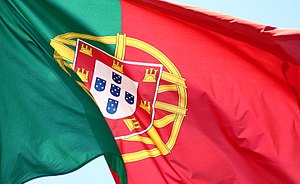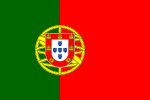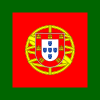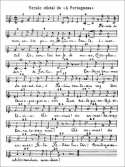The symbols of Portugal are official and unofficial flags, icons or cultural expressions that are emblematic, representative or otherwise characteristic of Portugal and of its culture.

The symbols of Portugal are official and unofficial flags, icons or cultural expressions that are emblematic, representative or otherwise characteristic of Portugal and of its culture.

|
Main articles: Flag of Portugal and List of Portuguese flags |

|
The present national flag of Portugal was introduced after the establishment of the republican regime in the 5 October 1910 Revolution. It is the latest in a series of national flags since the 12th century. Since at least the 15th century, the flags of Portugal had been known as "Bandeira das Quinas" (Flag of the Quinas), the quina being each one of the five escutcheons of the Portuguese coat of arms that are the central motif of the flag. The present flag is also referred as the "Bandeira Verde-Rubra" (Green-Red Flag). The present flag model was approved by the Provisional Government of the Portuguese Republic on 29 November 1910 and confirmed by the National Constituent Assembly through a Decree of 19 June 1911. The regulation of this decree – with the design specifications of the national flag, military colours, naval jack and commissioning pennant – was published in the Diário do Governo (official journal) on 30 June 1911. The national flag was constitutionally confirmed as a national symbol in the Portuguese Constitution of 1976.[1][2][3] |
 |
The national colours are the portable flags used by certain military, police and fire brigade units in formations, parades and other ceremonies. The colours used to be referred as the "regimental flag" and now are referred as the "national standard". The members of the Armed Forces make their oath of allegiance before the national colours. The national military colours of Portugal general model was established at the same time as the national flag. Despite the existence of a general model, each branch of the Armed Forces established their own model of colours.[1] |
 |
The national jack is a variant of the national flag hosted at the bow of warships when they are anchored. The present model of the jack was established at the same time as the national flag.[1] |
| The commissioning pennant is a long pennant hosted in the top of the main mast of warships which are commanded by officers. As Portugal does not have a separate war ensign, the commissioning pennant serves as the sign that a ship is a warship. The present model of the commissioning pennant was established at the same time as the national flag.[1] | |
 |
The national cockade of Portugal is red and green, with this last color occupying the center. In the past, the cockade was one of the most important national symbols, being used by the military, police and some other public employees in their uniform headdresses and also by many civilians to show their patriotism. For a while, the cockade served also as the roundel of the Portuguese military aircraft, later being replaced by the cross of the Order of Christ. However, today, the cockade is rarely used and largely forgotten, despite still being used in the famous shako (barretina) of the dress uniform of the Military College.[4] |
|
Main articles: Coat of arms of Portugal and Portuguese heraldry |

|
The present model of the coat of arms of Portugal was established at the same time as the national flag, being approved by the Provisional Government of the Portuguese Republic on 29 November 1910, with its specifications being formalized on 30 June 1911. Three versions of the coat of arms were established. The basic version, intended to be included in the national flag, consists of the traditional Portuguese shield laid over a golden armillary sphere. The version to be used in coins and emblems consists of the basic version surrounded by two olive branches, tied in the bottom by a ribbon (usually represented in green and red). The third version, intended to be included in the national colours of the military units, is similar to the previous one, but the ribbon is white with the wording Esta é a ditosa Pátria minha amada (this is my famous loved Motherland). |
 |
The Portuguese shield is the result of centuries of modifications and alterations. Starting with the Count Henry of Portugal's blue cross on a silver field shield, successive elements were added or taken, culminating with the complex heraldic design that was officially adopted in 1481 and kept until today. The shield consist of the five quinas (blue escutcheons with five besants) over an argent field and a red burdure charged with gold castles (fixed in seven since the end of 16th century). The complete achievement of arms, adopted in 1911, include the Portuguese shield over the armillary sphere |
 |
The armillary sphere was initially the personal badge of the future king Manuel I of Portugal, still when he was duke of Beja and great master of the Order of Christ. It became a national symbol when Manuel become king of Portugal, being associated with the Portuguese Discoveries and specially used to represent the Portuguese Empire. The coat of arms of Portugal adopted in 1911 has the armillary sphere as one of its main elements. |
 |
The cross of the Order of Christ (frequently referred simply as the cross of Christ) has been a national emblem since the reign of Manuel I, former great master of the Order. Despite not being one of the elements of the coat of arms of Portugal, it is extensively used as a national symbol. Namely, it was used in the sails of the ships of the Portuguese Discoveries and is still used today in the sails of the Portuguese Navy's school ship Sagres, in the Portuguese Air Force's aircraft roundels and in the badges of several Portuguese national sports teams. |
|
Main articles: A Portuguesa and Maria da Fonte anthem |

A Portuguesa (The Portuguese) is the national anthem of Portugal.
It was composed by Alfredo Keil and written by Henrique Lopes de Mendonça during the resurgent nationalist movement ignited by the 1890 British Ultimatum to Portugal concerning its African colonies. Used as the marching song of the failed republican rebellion of January 1891, in Porto, it was adopted as the national anthem of the newborn Portuguese Republic in 1911, replacing the Hino da Carta (Charter Anthem) which was the Portuguese national anthem during the period of the deposed constitutional monarchy. The Hino da Carta had in turn replaced in 1834, the Hino Patriótico (Patriotic Anthem), used until then as a semi-official national anthem.
The current official version of the A Portuguesa was approved by the Portuguese Council of Ministers on 16 July 1957.
The A Portuguesa was constitutionally confirmed as a national symbol in the Portuguese Constitution of 1976.[3]
Portugal has also a secondary official anthem, which is the Maria da Fonte anthem. This anthem is used in certain occasions – during military and civic ceremonies – when the A Portuguesa does not apply, namely, serving as honors music to the Speaker of the Parliament, the Prime Minister and Cabinet, the President of the Supreme Court of Justice and the military heads of the Armed Forces, Navy, Army and Air Force.[5]
|
Main article: Culture of Portugal |
|
Main articles: Fauna of Portugal and Flora of Portugal |
|
Main article: Portuguese cuisine |
|
See also: List of Portuguese people |